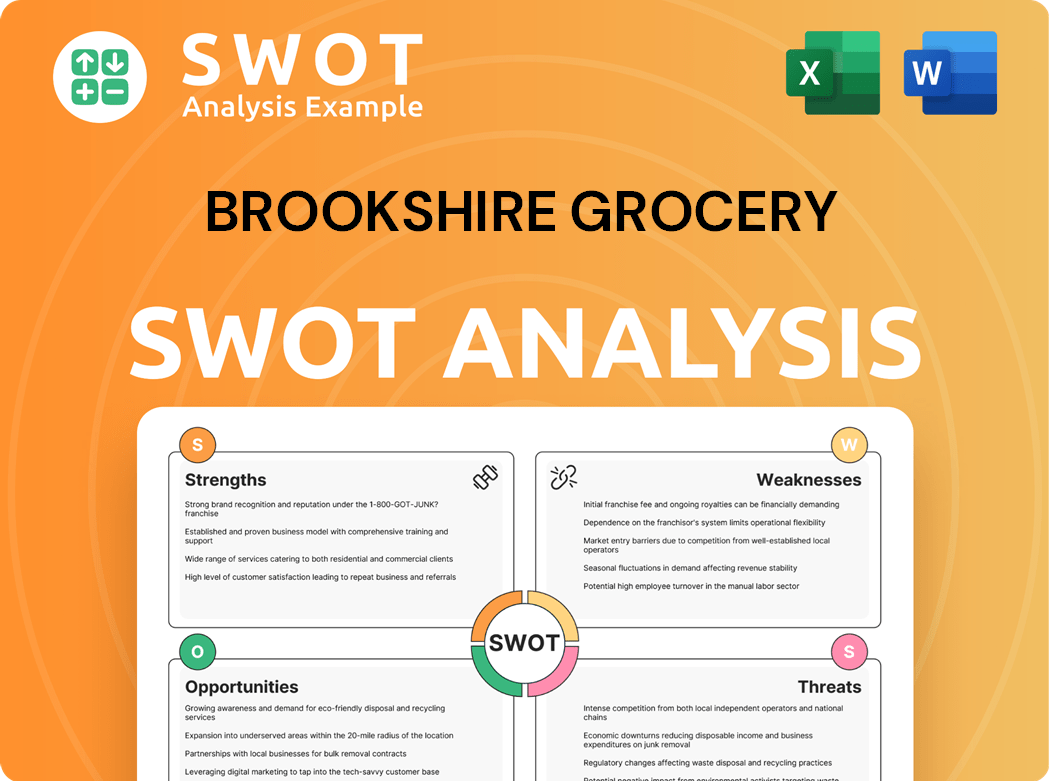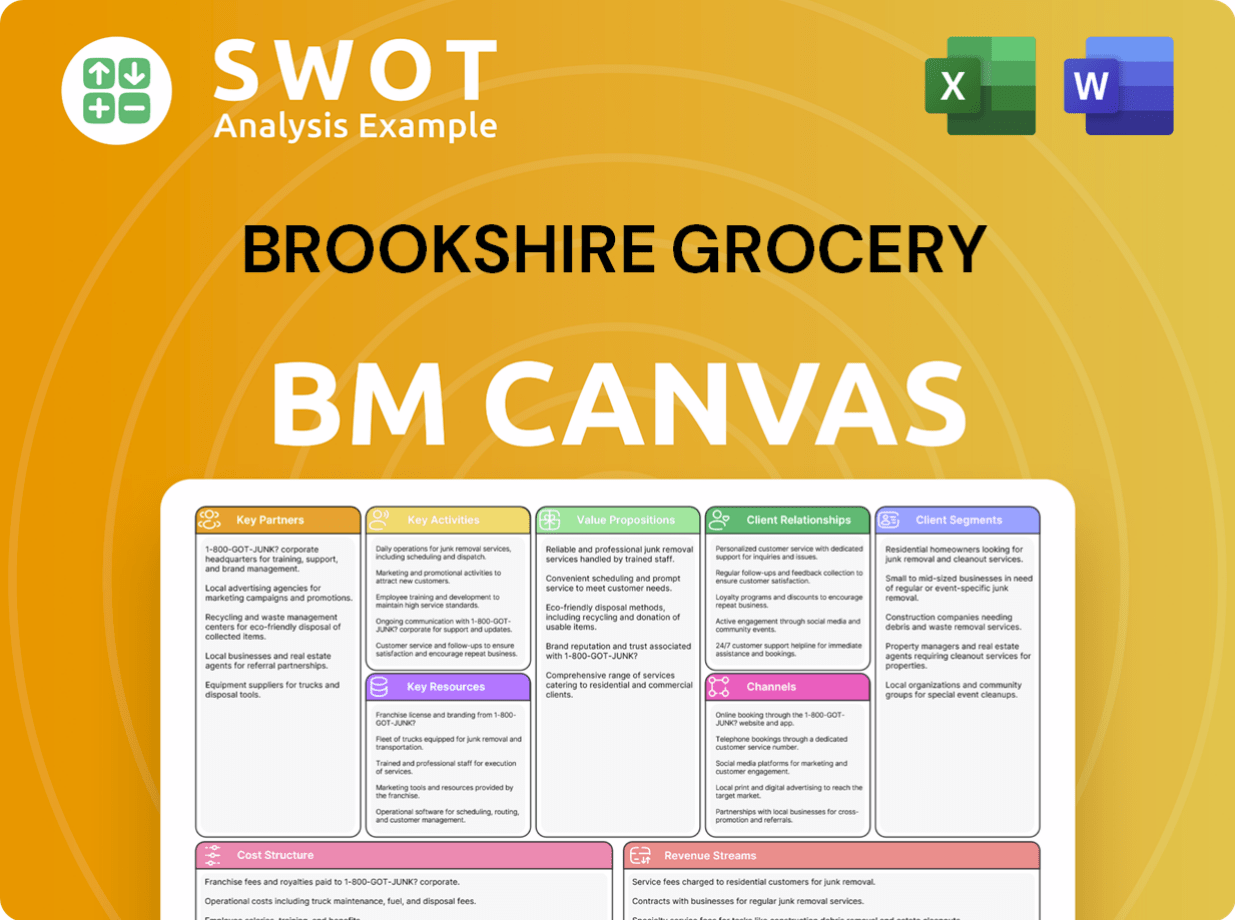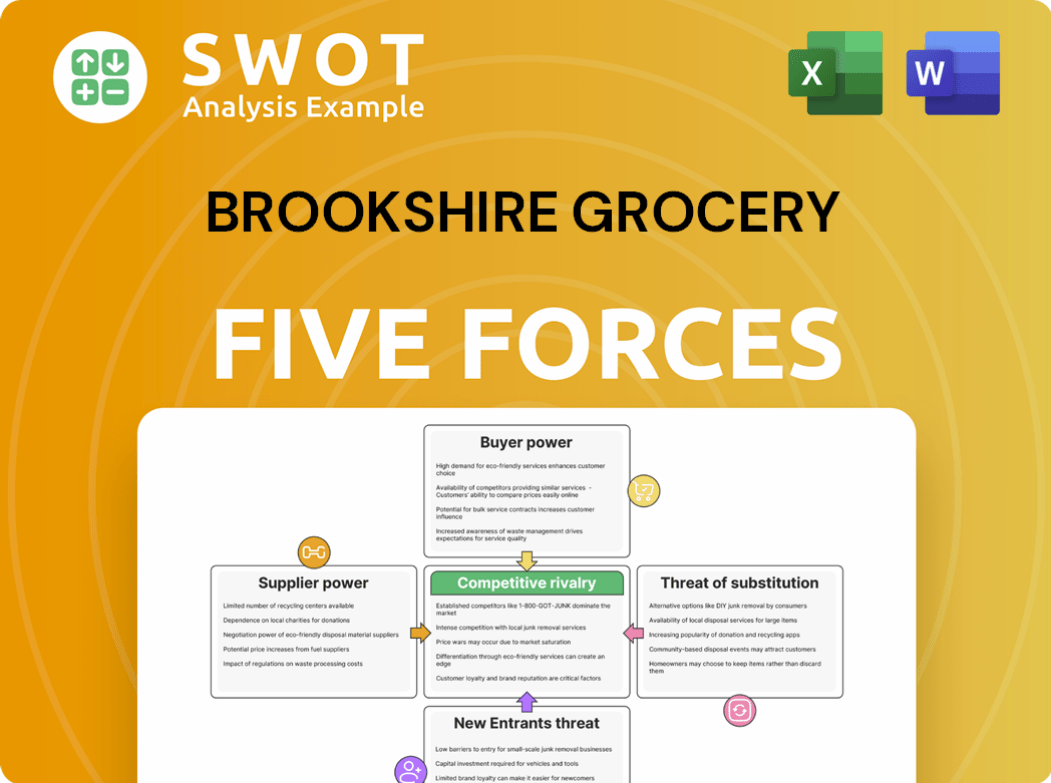Brookshire Grocery Bundle
How did Brookshire Grocery Company become a regional powerhouse?
Discover the compelling story of Brookshire Grocery Company (BGC), a grocery store chain that began with a groundbreaking vision in 1928. From its humble beginnings in East Texas, Brookshire's pioneered the self-service model, revolutionizing the shopping experience. This Brookshire Grocery SWOT Analysis will give you insights into the company's growth and strategies.

Explore the brief history of Brookshire Grocery Company, tracing its remarkable journey from a single store to a multi-state enterprise. Learn about the key milestones and strategic decisions that have shaped Brookshire's, including its early adoption of air conditioning and its commitment to customer service. This overview of the BGC history reveals the evolution of one of Texas's most beloved supermarket chains, highlighting its enduring legacy and expansion history.
What is the Brookshire Grocery Founding Story?
The Competitors Landscape of Brookshire Grocery began on September 1, 1928, marking the inception of what would become a significant player in the grocery store chain industry. Founded by Wood T. Brookshire and his cousin W.A. Brookshire, the company's journey started in downtown Tyler, Texas.
Wood T. Brookshire, with a background in the grocery business, envisioned a different approach. His vision, rooted in community service, shaped the company's core values from the outset. This commitment, combined with innovative practices, set the stage for the company’s future growth.
The founding of Brookshire Grocery Company is a story of innovation and community focus. The company's early success was built on a 'cash and carry' model, a departure from the credit-based practices common at the time. The company's initial store was a modest 25 by 100 feet, employing only four people.
Wood T. Brookshire and W.A. Brookshire founded Brookshire Grocery Company on September 1, 1928, in Tyler, Texas.
- Wood T. Brookshire, born in 1904, had experience from his brothers' grocery store, Brookshire Brothers.
- The initial store was a 'cash and carry' model, a new concept at the time.
- The first store was among the first air-conditioned grocery stores in East Texas.
- By 1939, Wood T. Brookshire owned three stores in Tyler.
Brookshire Grocery SWOT Analysis
- Complete SWOT Breakdown
- Fully Customizable
- Editable in Excel & Word
- Professional Formatting
- Investor-Ready Format

What Drove the Early Growth of Brookshire Grocery?
The early growth of the Brookshire Grocery Company (BGC) laid the foundation for its future success. This period saw the Grocery store chain expand its footprint and adapt to changing consumer behaviors. Key milestones included strategic expansions and the introduction of new store formats, solidifying its position in the market.
During the 1940s, Brookshire Grocery Company expanded significantly. The company added five new stores in East Texas, including locations in Longview, Winnsboro, Gladewater, and Kilgore. By the end of the decade, the chain had grown to nine stores, marking a period of steady growth. The construction of its first shopping center store in 1949 responded to the post-war suburbanization trend.
The 1950s saw further expansion of Brookshire's locations, with new stores opening in Corsicana, Marshall, Paris, Greenville, and Mt. Pleasant. To support this growth, the company constructed its first grocery warehouse in Tyler in 1953. This development was crucial for efficient supply chain management as the chain grew.
In the 1960s, BGC history ventured beyond Texas for the first time, expanding into Louisiana with stores in Shreveport and Natchitoches in 1961. By the end of the decade, the company operated 31 supermarkets, including eight in Louisiana. A new 175,000-square-foot distribution center was built in Tyler in 1968 to support the growing number of stores. For more information about the company's leadership, you can read about the Owners & Shareholders of Brookshire Grocery.
The 1970s were a period of significant growth for the company. By the end of the decade, the company doubled in size to 59 stores across three states: Texas, Louisiana, and Arkansas. Expansion into Arkansas occurred in 1975. In 1984, the company launched its Super 1 Foods banner, a no-frills, warehouse-format store, with the first location in Alexandria, Louisiana. By 1984, the company operated over 70 stores and employed more than 4,000 people.
Brookshire Grocery PESTLE Analysis
- Covers All 6 PESTLE Categories
- No Research Needed – Save Hours of Work
- Built by Experts, Trusted by Consultants
- Instant Download, Ready to Use
- 100% Editable, Fully Customizable

What are the key Milestones in Brookshire Grocery history?
The Brookshire Grocery Company (BGC) has achieved numerous milestones throughout its history, solidifying its position as a prominent player in the grocery industry. From its early days to recent expansions, the company has consistently adapted and grown, reflecting its commitment to serving its customers and communities. Learn more about the Mission, Vision & Core Values of Brookshire Grocery.
| Year | Milestone |
|---|---|
| 1928 | Founded, marking the beginning of the BGC's journey in the grocery business. |
| 1939 | Introduced air-conditioned stores in East Texas, enhancing the shopping experience. |
| 1984 | Launched the Super 1 Foods banner, expanding into a warehouse-style, discount format. |
| 2016 | Acquired and rebranded 25 former Walmart Express stores as Spring Market locations. |
| 2021 | Acquired Reasor's, adding 17 stores in Oklahoma and expanding its operational footprint. |
| 2024 | Implemented Logile's workforce management solutions across its 209 retail locations. |
Innovation has been a key driver for Brookshire's success, with the company consistently seeking ways to improve its operations and customer service. Early adoption of air-conditioned stores and the 'cash and carry' model set the stage for future advancements.
In 1939, Brookshire's pioneered air-conditioned stores in East Texas, providing a more comfortable shopping environment. This innovation set a new standard for customer experience in the region.
The company implemented a 'cash and carry' self-service model from its founding, moving away from credit-based transactions. This approach streamlined operations and enhanced efficiency.
The introduction of the Super 1 Foods banner in 1984 expanded the company's offerings into a warehouse-style, discount format. This diversification catered to a broader customer base.
In 2016, BGC acquired former Walmart Express stores and rebranded them as Spring Market locations. This strategic move expanded the company's presence and market reach.
The acquisition of Reasor's in late 2021 added 17 stores in Oklahoma to BGC's portfolio. This expansion enhanced its operational footprint and banner diversity.
In 2024, BGC implemented Logile's workforce management solutions across its 209 retail locations. This initiative aimed to improve operational efficiency and streamline workforce management.
Despite its successes, Brookshire Grocery Company has faced various challenges, including economic downturns and competitive pressures. The company has addressed these issues through continuous store updates, technological investments, and a focus on customer service.
Economic downturns have presented challenges, requiring the company to adapt its strategies and maintain financial stability. BGC has focused on operational efficiency and customer value.
Competition from other grocery store chains has necessitated continuous innovation and improvement. BGC has responded by investing in technology and enhancing customer service.
Supply chain issues, though improved by March 2023, posed challenges for the industry. BGC has worked to mitigate these issues to ensure product availability.
Labor issues have been an ongoing challenge for the grocery industry. BGC has focused on employee retention and creating a positive work environment.
The company's continuous investment in its facilities, such as the 2024 implementation of Logile's workforce management solutions, demonstrates its commitment to overcoming operational challenges. This investment enhances efficiency.
BGC has maintained its focus on customer service and operational efficiency. The company's commitment to customer satisfaction has been a key factor in its success.
Brookshire Grocery Business Model Canvas
- Complete 9-Block Business Model Canvas
- Effortlessly Communicate Your Business Strategy
- Investor-Ready BMC Format
- 100% Editable and Customizable
- Clear and Structured Layout

What is the Timeline of Key Events for Brookshire Grocery?
The BGC history is marked by significant milestones, starting with its inception in 1928. From a single store in Tyler, Texas, the company expanded, introduced innovative concepts, and strategically acquired other grocery chains to establish a strong presence in the Southern United States. The evolution reflects adaptability and a commitment to customer service, shaping its legacy in the competitive grocery market.
| Year | Key Event |
|---|---|
| 1928 | Wood T. Brookshire opens the first store in Tyler, Texas, initiating the 'cash and carry' self-service model. |
| 1939 | Wood T. Brookshire takes sole ownership, forming the foundation of Brookshire Grocery Company and opens the first air-conditioned grocery store in East Texas. |
| 1961 | Expansion into Louisiana begins with stores in Shreveport and Natchitoches, marking the start of its regional growth. |
| 1984 | The first Super 1 Foods store, a warehouse-format concept, opens in Alexandria, Louisiana. |
| 1993 | The Brookshire Pharmacy Division is launched, expanding service offerings to customers. |
| 2016 | The Spring Market banner is launched with the conversion of 25 former Walmart Express stores. |
| 2021 | Brookshire Grocery Company acquires Reasor's, adding stores in Oklahoma. |
| 2024 | Brookshire Grocery Company announces plans to acquire four Shoppin' Baskit locations in West Texas, which will become Spring Market stores in December 2024, and completes implementation of Logile's retail labor planning and workforce management solutions across its 209 retail locations. Local Bounti expands distribution to over 180 Brookshire Grocery Company locations. |
The company is focused on expanding its market presence. This involves strategic acquisitions and the conversion of existing locations into new banners like Spring Market. These moves indicate a proactive approach to growth within the grocery store chain industry, aiming to increase its footprint.
Ongoing store remodels are a key part of the strategy. These renovations aim to improve the customer shopping experience and create a better working environment for employees. This focus underscores a commitment to both customer satisfaction and employee well-being.
Technology plays a crucial role in BGC's future. Numerous projects are underway to improve operational efficiency and adapt to industry trends. This includes the implementation of advanced workforce management solutions across all locations.
BGC remains dedicated to its founding principles of exceptional customer service and community support. Despite the growth of online shopping, the company recognizes the importance of brick-and-mortar stores for the social aspects of grocery shopping, especially among older consumers.
Brookshire Grocery Porter's Five Forces Analysis
- Covers All 5 Competitive Forces in Detail
- Structured for Consultants, Students, and Founders
- 100% Editable in Microsoft Word & Excel
- Instant Digital Download – Use Immediately
- Compatible with Mac & PC – Fully Unlocked

Related Blogs
- What is Competitive Landscape of Brookshire Grocery Company?
- What is Growth Strategy and Future Prospects of Brookshire Grocery Company?
- How Does Brookshire Grocery Company Work?
- What is Sales and Marketing Strategy of Brookshire Grocery Company?
- What is Brief History of Brookshire Grocery Company?
- Who Owns Brookshire Grocery Company?
- What is Customer Demographics and Target Market of Brookshire Grocery Company?
Disclaimer
All information, articles, and product details provided on this website are for general informational and educational purposes only. We do not claim any ownership over, nor do we intend to infringe upon, any trademarks, copyrights, logos, brand names, or other intellectual property mentioned or depicted on this site. Such intellectual property remains the property of its respective owners, and any references here are made solely for identification or informational purposes, without implying any affiliation, endorsement, or partnership.
We make no representations or warranties, express or implied, regarding the accuracy, completeness, or suitability of any content or products presented. Nothing on this website should be construed as legal, tax, investment, financial, medical, or other professional advice. In addition, no part of this site—including articles or product references—constitutes a solicitation, recommendation, endorsement, advertisement, or offer to buy or sell any securities, franchises, or other financial instruments, particularly in jurisdictions where such activity would be unlawful.
All content is of a general nature and may not address the specific circumstances of any individual or entity. It is not a substitute for professional advice or services. Any actions you take based on the information provided here are strictly at your own risk. You accept full responsibility for any decisions or outcomes arising from your use of this website and agree to release us from any liability in connection with your use of, or reliance upon, the content or products found herein.